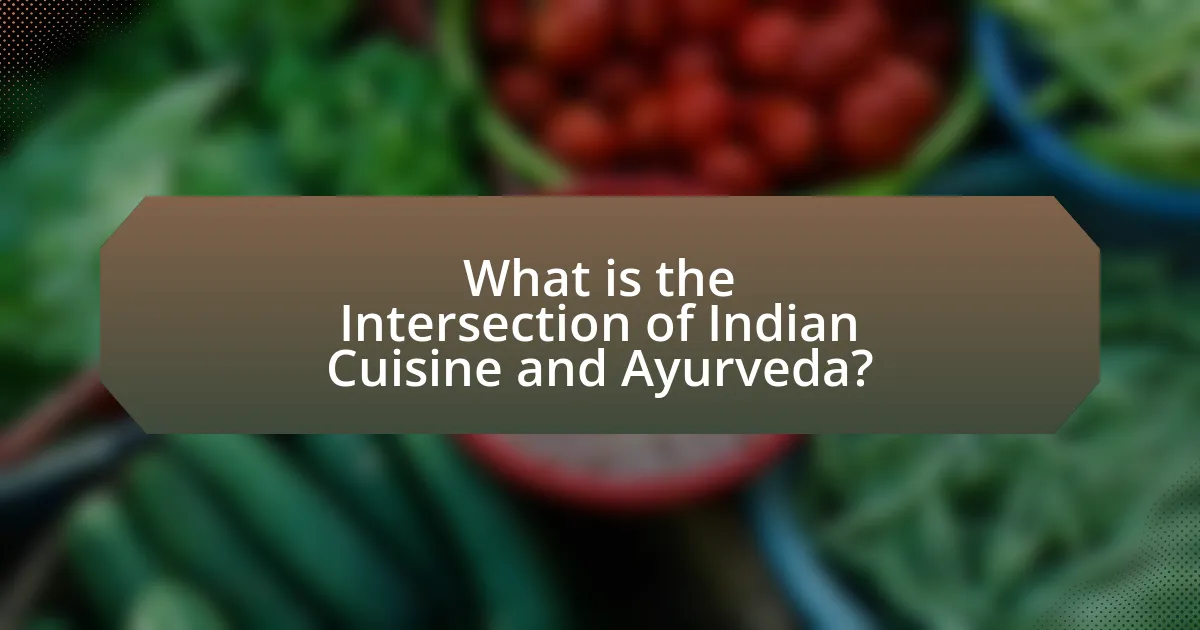The article explores the intersection of Indian cuisine and Ayurveda, emphasizing the concept of food as medicine. It outlines how Ayurvedic principles categorize foods based on their qualities and effects on the body, promoting balance among the three doshas: Vata, Pitta, and Kapha. Key components include the significance of the six tastes, the role of digestion, and the importance of seasonal eating. Additionally, the article discusses how traditional Indian dishes and spices align with Ayurvedic practices to enhance health and well-being, providing practical tips for integrating these concepts into daily meals.

What is the Intersection of Indian Cuisine and Ayurveda?
The intersection of Indian cuisine and Ayurveda lies in the principle that food serves as medicine, emphasizing the healing properties of ingredients based on their qualities and effects on the body. Ayurveda categorizes foods according to their taste, energy, and post-digestive effects, guiding dietary choices to promote balance among the body’s three doshas: Vata, Pitta, and Kapha. For example, spices like turmeric and ginger are commonly used in Indian cooking not only for flavor but also for their anti-inflammatory and digestive benefits, aligning with Ayurvedic practices that advocate for the use of natural ingredients to enhance health and well-being. This holistic approach is rooted in ancient texts, such as the Charaka Samhita, which detail the therapeutic uses of various foods and herbs, reinforcing the connection between culinary practices and health in Indian culture.
How do Indian Cuisine and Ayurveda complement each other?
Indian cuisine and Ayurveda complement each other by integrating the principles of balance and health through food. Ayurveda emphasizes the importance of diet in maintaining health and preventing disease, advocating for the use of specific ingredients that align with an individual’s dosha, or body constitution. For instance, spices like turmeric and ginger, commonly used in Indian cooking, are recognized in Ayurveda for their anti-inflammatory and digestive properties. This synergy between the culinary practices of Indian cuisine and the holistic approach of Ayurveda creates meals that are not only flavorful but also therapeutic, promoting overall well-being and harmony within the body.
What are the foundational principles of Ayurveda in relation to food?
The foundational principles of Ayurveda in relation to food emphasize balance, individual constitution, and the qualities of food. Ayurveda categorizes food based on its effects on the body and mind, focusing on the three doshas—Vata, Pitta, and Kapha—which represent different body types and energies. Each person has a unique constitution that determines their dietary needs, and food is viewed as medicine that can either promote health or cause imbalance.
Ayurveda also considers the six tastes—sweet, sour, salty, bitter, pungent, and astringent—as essential for a balanced diet, as each taste influences the doshas differently. Additionally, the timing of meals, food preparation methods, and the freshness of ingredients are crucial for optimal digestion and health. These principles are rooted in ancient texts, such as the Charaka Samhita, which outlines the importance of diet in maintaining health and preventing disease.
How does Indian Cuisine reflect Ayurvedic principles?
Indian cuisine reflects Ayurvedic principles through its emphasis on balance, digestion, and the use of specific ingredients to promote health. Ayurvedic philosophy categorizes foods based on their qualities and effects on the body, aligning with the three doshas: Vata, Pitta, and Kapha. For instance, spices like turmeric and ginger are commonly used in Indian cooking for their anti-inflammatory properties, which support digestion and overall wellness. Additionally, meals are often designed to be harmonious in taste—sweet, sour, salty, bitter, pungent, and astringent—ensuring a balanced intake that aligns with Ayurvedic dietary guidelines. This integration of health-focused ingredients and balanced flavors demonstrates how Indian cuisine serves as a practical application of Ayurvedic principles, promoting food as a form of medicine.
Why is food considered medicine in Ayurveda?
Food is considered medicine in Ayurveda because it is believed to have the power to balance the body’s energies, known as doshas, and promote overall health. Ayurveda emphasizes that the right foods can prevent disease, enhance vitality, and support healing processes. This perspective is rooted in the understanding that food contains specific qualities and energies that can influence physical and mental well-being, aligning with the principles of holistic health. For instance, Ayurvedic texts categorize foods based on their effects on the body, such as heating or cooling properties, which can be used to treat various ailments.
What role does digestion play in Ayurvedic medicine?
Digestion plays a central role in Ayurvedic medicine, as it is considered the foundation of health and well-being. In Ayurveda, the process of digestion, known as “Agni,” is vital for transforming food into energy and nutrients that nourish the body. A balanced Agni is believed to promote optimal health, while a weak or imbalanced Agni can lead to the accumulation of toxins, known as “Ama,” which can cause various health issues. Ayurvedic texts emphasize that proper digestion is essential for maintaining the balance of the three doshas—Vata, Pitta, and Kapha—thereby influencing overall physical and mental health.
How do different food types affect the doshas in Ayurveda?
Different food types significantly affect the doshas in Ayurveda by either balancing or aggravating them. For instance, sweet, sour, and salty tastes tend to pacify Vata dosha, while bitter, pungent, and astringent tastes can aggravate it. Similarly, Pitta dosha is balanced by sweet, bitter, and astringent foods, whereas sour and salty foods can increase it. Kapha dosha is soothed by bitter, pungent, and astringent tastes, while sweet, sour, and salty foods can exacerbate it. This classification is rooted in Ayurvedic principles, which emphasize that the qualities of food correspond to the qualities of the doshas, influencing overall health and well-being.
What are the key components of Ayurvedic dietary practices?
The key components of Ayurvedic dietary practices include the principles of balance, individual constitution (dosha), seasonal eating, and mindful consumption. Balance refers to the harmony of the six tastes—sweet, sour, salty, bitter, pungent, and astringent—essential for optimal health. Individual constitution, or dosha, categorizes people into three types: Vata, Pitta, and Kapha, guiding food choices to maintain personal balance. Seasonal eating emphasizes consuming foods that align with the changing seasons to support bodily functions. Mindful consumption encourages awareness of food choices and eating habits, promoting digestion and overall well-being. These components collectively aim to enhance health and prevent disease, aligning with the Ayurvedic philosophy that food is medicine.
What are the six tastes in Ayurveda and their significance?
The six tastes in Ayurveda are sweet, sour, salty, bitter, pungent, and astringent, each playing a crucial role in balancing the body’s doshas and promoting health. Sweet taste nourishes and provides energy, sour taste aids digestion and stimulates appetite, salty taste enhances flavor and hydration, bitter taste detoxifies and purifies, pungent taste stimulates metabolism and circulation, and astringent taste helps in tissue contraction and absorption. These tastes are essential for creating balanced meals that align with individual constitution and health needs, as outlined in Ayurvedic texts like the Charaka Samhita, which emphasizes the importance of taste in dietary practices for maintaining health and wellness.
How does seasonal eating align with Ayurvedic principles?
Seasonal eating aligns with Ayurvedic principles by promoting the consumption of foods that correspond to the changing seasons, which helps maintain balance in the body. Ayurveda emphasizes the importance of aligning dietary choices with the natural rhythms of the environment, as different seasons affect the doshas—Vata, Pitta, and Kapha. For instance, during winter, heavier and warming foods are recommended to counteract the cold, while in summer, lighter and cooling foods are advised to balance the heat. This approach is supported by the Ayurvedic belief that food is medicine, and consuming seasonal produce enhances digestion and overall health by providing the nutrients needed for the body’s specific needs at different times of the year.

How does Indian Cuisine utilize Ayurvedic concepts?
Indian cuisine utilizes Ayurvedic concepts by emphasizing the balance of the three doshas—Vata, Pitta, and Kapha—through the selection and preparation of ingredients. Each food item is categorized based on its qualities, such as taste, temperature, and effect on the body, which helps in promoting health and preventing disease. For example, spices like turmeric and ginger are used not only for flavor but also for their anti-inflammatory properties, aligning with Ayurveda’s focus on healing through food. This approach is supported by the Ayurvedic principle that food is medicine, where meals are tailored to individual constitution and health needs, ensuring optimal digestion and nourishment.
What are some traditional Indian dishes that embody Ayurvedic principles?
Traditional Indian dishes that embody Ayurvedic principles include Kitchari, a balanced dish made from rice and lentils, which is often used for detoxification and balancing the doshas. Another example is Khichdi, which combines various spices and vegetables, promoting digestion and nourishment. Additionally, Ayurvedic curries, such as those made with turmeric and ginger, support inflammation reduction and overall health. These dishes are designed to harmonize the body, mind, and spirit, reflecting the core tenets of Ayurveda that emphasize balance and holistic well-being.
How do spices in Indian Cuisine enhance health according to Ayurveda?
Spices in Indian cuisine enhance health according to Ayurveda by balancing the body’s doshas, which are the fundamental energies that govern physiological and psychological processes. For instance, turmeric contains curcumin, known for its anti-inflammatory and antioxidant properties, which supports immune function and reduces inflammation. Similarly, ginger aids digestion and alleviates nausea, while cumin enhances metabolism and promotes healthy digestion. These spices are not only flavor enhancers but also serve as natural remedies, aligning with Ayurveda’s principle of using food as medicine to maintain health and prevent disease.
What are the benefits of using ghee in Ayurvedic cooking?
Ghee offers numerous benefits in Ayurvedic cooking, primarily due to its nourishing and healing properties. It is considered a sattvic food, promoting clarity and purity of mind, which aligns with Ayurvedic principles of balance and wellness. Ghee aids in digestion by enhancing the absorption of nutrients and is known to have anti-inflammatory properties, making it beneficial for various health conditions. Additionally, ghee is rich in butyrate, a short-chain fatty acid that supports gut health and has been linked to improved immune function. Its high smoke point makes it ideal for cooking, as it does not produce harmful free radicals when heated. These attributes underscore ghee’s integral role in Ayurvedic dietary practices, emphasizing its value as both a cooking medium and a health-promoting ingredient.
How can one adapt Indian Cuisine for Ayurvedic healing?
To adapt Indian cuisine for Ayurvedic healing, one should focus on balancing the three doshas: Vata, Pitta, and Kapha. This involves selecting ingredients and spices that correspond to the individual’s dosha type, such as using warming spices like ginger and cinnamon for Vata, cooling herbs like coriander and mint for Pitta, and grounding foods like lentils and root vegetables for Kapha. Additionally, cooking methods should emphasize digestion, such as steaming or sautéing, and meals should be consumed warm to enhance digestive fire (Agni). Research indicates that Ayurvedic principles can improve health outcomes by promoting dietary choices that align with individual constitution and seasonal changes, thus reinforcing the connection between food and wellness.
What modifications can be made to recipes for different dosha types?
To modify recipes for different dosha types, one must consider the characteristics of Vata, Pitta, and Kapha doshas. For Vata, recipes should include warm, moist, and grounding ingredients like cooked grains, healthy fats, and spices such as ginger and cinnamon to balance the dry and cool qualities of Vata. For Pitta, recipes should focus on cooling, hydrating, and soothing ingredients like leafy greens, coconut, and sweet fruits, while avoiding overly spicy or acidic foods that can aggravate Pitta. For Kapha, recipes should incorporate light, stimulating, and warming ingredients such as legumes, bitter greens, and spices like turmeric and black pepper to counteract the heavy and cold nature of Kapha. These modifications align with Ayurvedic principles that emphasize balancing the doshas through diet, ensuring that each type receives the appropriate nutritional support to maintain harmony.
How can cooking methods impact the nutritional value of Ayurvedic dishes?
Cooking methods significantly impact the nutritional value of Ayurvedic dishes by altering the bioavailability of nutrients and the overall health benefits of the ingredients used. For instance, steaming vegetables retains more vitamins and minerals compared to boiling, which can leach nutrients into the cooking water. Additionally, Ayurvedic principles emphasize the importance of cooking techniques that enhance digestion and absorption, such as sautéing spices in ghee, which can increase the absorption of fat-soluble vitamins. Research indicates that certain cooking methods, like slow cooking, can preserve the antioxidant properties of herbs and spices, thereby maximizing their medicinal benefits. Therefore, the choice of cooking method directly influences the nutritional efficacy of Ayurvedic cuisine.

What practical tips can enhance the integration of Indian Cuisine and Ayurveda?
To enhance the integration of Indian Cuisine and Ayurveda, individuals should focus on using seasonal and locally sourced ingredients. This practice aligns with Ayurvedic principles that emphasize the importance of fresh produce for maintaining balance in the body. Incorporating spices such as turmeric, ginger, and cumin not only enhances flavor but also provides medicinal benefits recognized in Ayurveda, such as anti-inflammatory and digestive properties. Additionally, meal preparation should consider individual dosha types—Vata, Pitta, and Kapha—ensuring that meals are tailored to promote optimal health based on one’s unique constitution. This approach is supported by Ayurvedic texts that advocate for personalized nutrition as a means to achieve wellness.
How can individuals incorporate Ayurvedic principles into their daily meals?
Individuals can incorporate Ayurvedic principles into their daily meals by focusing on the balance of the three doshas: Vata, Pitta, and Kapha. This can be achieved by selecting foods that align with one’s dosha type, such as incorporating warm, moist foods for Vata, cooling foods for Pitta, and light, dry foods for Kapha.
For example, a Vata individual may benefit from cooked grains, root vegetables, and healthy fats, while a Pitta individual might thrive on fresh fruits, leafy greens, and cooling spices like coriander. Kapha individuals should emphasize lighter foods like legumes, bitter greens, and spices that stimulate digestion, such as ginger and black pepper.
Additionally, incorporating spices like turmeric, cumin, and fennel not only enhances flavor but also supports digestion and overall health, aligning with Ayurvedic teachings that emphasize food as medicine. This approach is supported by Ayurvedic texts, which advocate for personalized nutrition based on individual constitution and seasonal changes.
What are some easy Ayurvedic recipes to start with?
Some easy Ayurvedic recipes to start with include Kitchari, Turmeric Milk, and Cumin-Spiced Lentils. Kitchari, a staple in Ayurvedic diets, combines rice and mung beans with spices like cumin and ginger, promoting digestion and detoxification. Turmeric Milk, made by heating milk with turmeric and a sweetener, is known for its anti-inflammatory properties and supports overall health. Cumin-Spiced Lentils, prepared by cooking lentils with cumin seeds and vegetables, provide protein and aid digestion. These recipes are simple to make and embody the Ayurvedic principle of using food as medicine.
How can meal planning be aligned with Ayurvedic dietary guidelines?
Meal planning can be aligned with Ayurvedic dietary guidelines by incorporating the principles of dosha balance, seasonal foods, and mindful eating practices. Ayurvedic guidelines emphasize the importance of understanding individual constitution (doshas)—Vata, Pitta, and Kapha—and tailoring meals to balance these energies. For instance, a person with a Pitta constitution may benefit from cooling foods like cucumbers and coconut, while a Vata individual might thrive on warm, grounding foods such as cooked grains and root vegetables.
Additionally, Ayurveda advocates for seasonal eating, suggesting that foods should be chosen based on their availability and alignment with the body’s needs throughout the year. For example, consuming lighter, cooling foods in summer and heavier, warming foods in winter supports overall health. Mindful eating practices, such as eating in a calm environment and paying attention to hunger cues, further enhance the alignment with Ayurvedic principles.
These practices are supported by Ayurvedic texts, which detail the significance of food as medicine and its role in maintaining balance and health.
What common mistakes should be avoided when merging Indian Cuisine with Ayurveda?
Common mistakes to avoid when merging Indian Cuisine with Ayurveda include neglecting individual dosha types, using incompatible ingredients, and overlooking seasonal variations. Each dosha—Vata, Pitta, and Kapha—requires specific food types for balance; failing to consider this can lead to health issues. For instance, combining cooling foods with heating spices without understanding their effects can disrupt bodily harmony. Additionally, Ayurveda emphasizes seasonal eating; ignoring this principle can result in ineffective dietary practices. Research indicates that aligning food choices with Ayurvedic principles enhances overall well-being, reinforcing the importance of these considerations in culinary practices.
How can one ensure balance in flavors and nutrition in Ayurvedic meals?
To ensure balance in flavors and nutrition in Ayurvedic meals, one should incorporate the six tastes—sweet, sour, salty, bitter, pungent, and astringent—into each meal. This approach aligns with Ayurvedic principles that advocate for a diverse palate to promote overall health and well-being. Each taste corresponds to specific elements and doshas, which are vital for maintaining bodily harmony. For instance, sweet and salty tastes can ground and nourish, while bitter and pungent tastes can detoxify and stimulate digestion. By balancing these tastes, individuals can achieve nutritional adequacy and flavor diversity, which is essential for both physical health and sensory satisfaction.
What resources are available for learning more about Ayurvedic cooking?
Books, online courses, and workshops are valuable resources for learning about Ayurvedic cooking. Notable books include “The Complete Book of Ayurvedic Cooking” by Julie Sahni, which provides comprehensive recipes and insights into Ayurvedic principles. Online platforms like Udemy and Coursera offer courses specifically focused on Ayurvedic cooking techniques and philosophies. Additionally, many wellness centers and Ayurvedic practitioners conduct workshops that teach the fundamentals of Ayurvedic cooking, emphasizing the connection between food and health. These resources collectively enhance understanding and practice of Ayurvedic culinary traditions.
